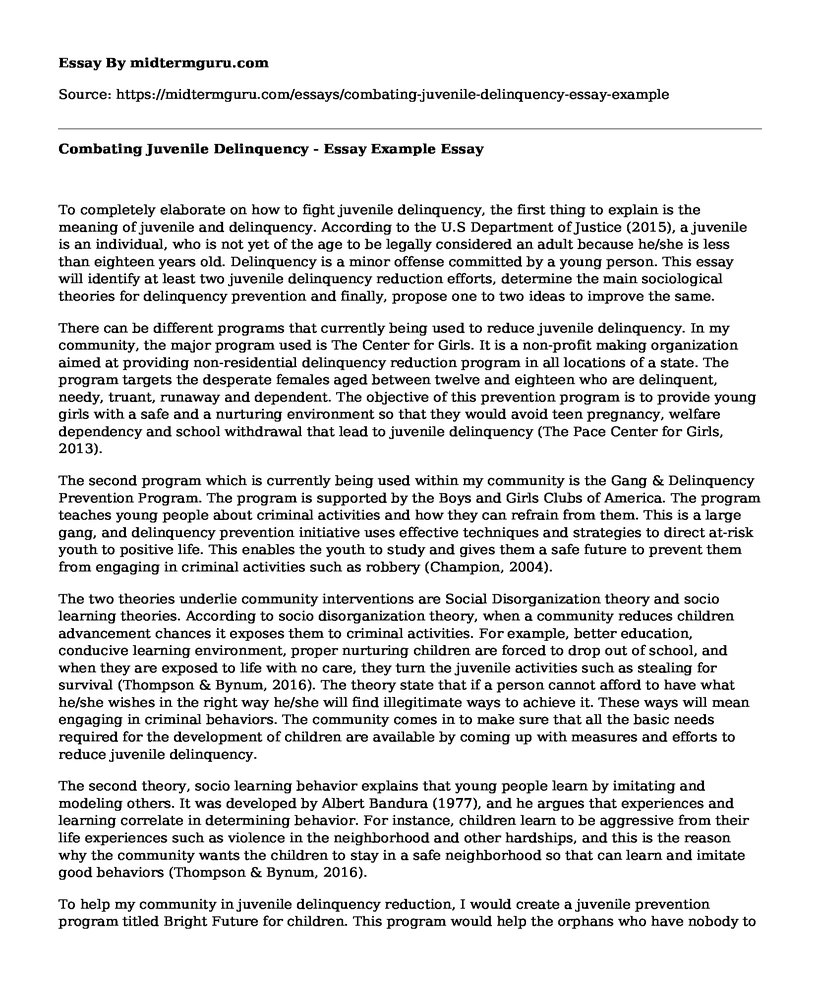To completely elaborate on how to fight juvenile delinquency, the first thing to explain is the meaning of juvenile and delinquency. According to the U.S Department of Justice (2015), a juvenile is an individual, who is not yet of the age to be legally considered an adult because he/she is less than eighteen years old. Delinquency is a minor offense committed by a young person. This essay will identify at least two juvenile delinquency reduction efforts, determine the main sociological theories for delinquency prevention and finally, propose one to two ideas to improve the same.
There can be different programs that currently being used to reduce juvenile delinquency. In my community, the major program used is The Center for Girls. It is a non-profit making organization aimed at providing non-residential delinquency reduction program in all locations of a state. The program targets the desperate females aged between twelve and eighteen who are delinquent, needy, truant, runaway and dependent. The objective of this prevention program is to provide young girls with a safe and a nurturing environment so that they would avoid teen pregnancy, welfare dependency and school withdrawal that lead to juvenile delinquency (The Pace Center for Girls, 2013).
The second program which is currently being used within my community is the Gang & Delinquency Prevention Program. The program is supported by the Boys and Girls Clubs of America. The program teaches young people about criminal activities and how they can refrain from them. This is a large gang, and delinquency prevention initiative uses effective techniques and strategies to direct at-risk youth to positive life. This enables the youth to study and gives them a safe future to prevent them from engaging in criminal activities such as robbery (Champion, 2004).
The two theories underlie community interventions are Social Disorganization theory and socio learning theories. According to socio disorganization theory, when a community reduces children advancement chances it exposes them to criminal activities. For example, better education, conducive learning environment, proper nurturing children are forced to drop out of school, and when they are exposed to life with no care, they turn the juvenile activities such as stealing for survival (Thompson & Bynum, 2016). The theory state that if a person cannot afford to have what he/she wishes in the right way he/she will find illegitimate ways to achieve it. These ways will mean engaging in criminal behaviors. The community comes in to make sure that all the basic needs required for the development of children are available by coming up with measures and efforts to reduce juvenile delinquency.
The second theory, socio learning behavior explains that young people learn by imitating and modeling others. It was developed by Albert Bandura (1977), and he argues that experiences and learning correlate in determining behavior. For instance, children learn to be aggressive from their life experiences such as violence in the neighborhood and other hardships, and this is the reason why the community wants the children to stay in a safe neighborhood so that can learn and imitate good behaviors (Thompson & Bynum, 2016).
To help my community in juvenile delinquency reduction, I would create a juvenile prevention program titled Bright Future for children. This program would help the orphans who have nobody to help them, those coming from poor backgrounds that cannot afford to maintain them and mostly the homeless. I would give them a safe environment and enroll them in schools so that they can have the skills required in the job markets. Eventually, they would have their carriers and will not be involved in juvenile crimes. This program has worked in the United States, so it is applicable and effective.
References
Thompson, W. E., & Bynum, J. E. (2016). Juvenile delinquency: A sociological approach. Rowman & Littlefield.Champion, D.J. (2004). The Juvenile Justice System: Delinquency, Processing, and the Law. 4th Ed. Upper Saddle River, NJ: Pearson Prentice Hall Inc.
The Pace Center for Girls, 2013.
Cite this page
Combating Juvenile Delinquency - Essay Example. (2021, Jun 30). Retrieved from https://midtermguru.com/essays/combating-juvenile-delinquency-essay-example
If you are the original author of this essay and no longer wish to have it published on the midtermguru.com website, please click below to request its removal:
- Essay on Sleepy Lagoon Murder Case
- Essay on the Us Supreme Courts Role in Society: How Representative Are They?
- Research Paper on Literacy and Social Justice
- Critical Essay on Race, Police, and the Making of a Political Identity
- US Gun Ownership: High Restrictions, Highest Violence - Essay Sample
- IRAC Method: Briefing a Case for Supreme Court - Essay Sample
- Paper Example on Prejudice in Police Profiling and Components of Effective Policing







